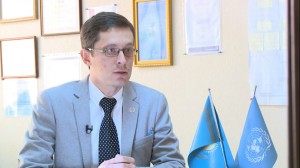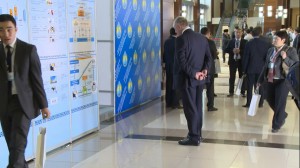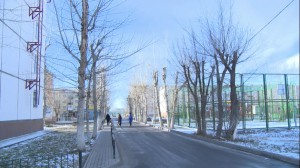 The government of Kazakhstan and the United Nations Development Programme (UNDP) are working together to reduce greenhouse gas emissions by creating a model for modernising inefficient district heating and other systems in Kazakhstan’s small cities. Alexander Belyi, a UNDP manager of the joint project, which is 80 percent funded by the government of Kazakhstan, spoke with The Astana Times about their goals and achievements.
The government of Kazakhstan and the United Nations Development Programme (UNDP) are working together to reduce greenhouse gas emissions by creating a model for modernising inefficient district heating and other systems in Kazakhstan’s small cities. Alexander Belyi, a UNDP manager of the joint project, which is 80 percent funded by the government of Kazakhstan, spoke with The Astana Times about their goals and achievements.
What is the goal of the project?
The project will develop and test, in a pilot territory [Prigorodnyi Village in Astana’s Yessil District], a model of modernisation and the subsequent efficient management of housing and utilities services (HUS), services for maintaining safe residences; provision of quality municipal and utilities services to the population through increasing the economic viability, environmental friendliness and reliability of life-support systems in housing and municipal infrastructure, primarily heating, water supply and electricity systems. …
There are about 60 small towns in Kazakhstan, with the total population of about 1.5 million. This is a serious reason to work on modernisation of municipal housing economy. Municipal housing economy of small cities is in much worse situation than in large cities or regional centres. This relates to the heritage of the past when proper repairs were not done. All those problems worsened. Buildings, systems of water and gas supply were of worse quality than in big cities. The issue of energy efficiency is closely related to the quality. If due to the poor quality of the systems the loss of heat is observed the talk of energy efficiency becomes an empty talk.
The task of the joint project is to show all the benefits of using energy-saving measures, equipment and materials and approaching the management of the municipal housing economy from the point of view of the quality of the energy structure and the benefits of energy saving. … Another task is to find a point where people will participate with local authorities and suppliers of resources to find compromises to repair the systems. … Over the past years, our 17 projects have showed that it is possible to improve efficiency and reduce costs. With small investments, it is possible to achieve 25-45 percent energy savings. People see the advantages and they are ready to invest in their own houses to reduce costs and increase their comfort.
How does the project function?
The project consists of four components. The first one is research. Last year, we collected all the information about the village; the buildings; the systems of engineering, heating, water supply. We elaborated the scenarios through which the municipal housing economy would develop in this locality. We already have the final reports; they will soon be posted on the UNDP website for the project.
The second component is almost finished. In addition to the technical measures, we are implementing organisational ones. They are aimed at modernising the management system of the municipal housing economy. We also considered the possibility of reforming communal services.
The third component is related to testing the decisions we made. It started this year. Here, we will create a sample project for modernising the municipal housing services in apartment buildings. … The third component will also include decisions related to alternative energy: using solar collectors, installing automated heating units in apartment buildings, replacing windows with better heat-preserving ones.
The fourth component will start by the end of the year. It includes monitoring what will be done and experience sharing. … We implemented 17 projects and we are monitoring them according to our indicators. The first is an economic indicator, the second one is environmental and the third is a technical indicator. Similar monitoring will be implemented in Prigorodnyi. We also plan to introduce a system of automated control that will provide the akimat (city administration) with information about what is going on there.
We will share our experience in five regions, five smaller locations where training seminars will be held for various target groups, mainly the owners of apartment buildings, akimats, heat-supplying companies and other communal enterprises.
What is the role of the UNDP in the project?
The UNDP renders support – we implement pilot demonstration facilities showing the advantages or disadvantages of ideas. This year, we plan to implement several pilot initiatives in Prigorodnyi and consider the possibility of installing solar collectors on one of the state-financed institutions (a kindergarten or school). …
UNDP projects get feedback: we always evaluate our work, identify mistakes we made and work on them, and if we see inefficient measures, we correct them.
How did you choose Prigorodnyi?
Prigorodnyi is a part of Astana, but this village is separate from the city. It has its own boiler-house, its own heating network; previously, it was a separate location. We believe this is a model where we can try all energy-saving measures. …
Before choosing the territory, consultations were held. It was the proposal of the beneficiary itself, the government: the then Agency for Construction Affairs (now a committee at the Ministry of Regional Development) and the Kazakhstan Centre for Modernisation and Development of Municipal Housing Economy. This village will be used as a model. … After introducing our system there, we can introduce the model around the country.
Another reason for choosing the village is its proximity to Astana. Astana is a large political, cultural and trade centre and the centre where decision-makers are concentrated. Showing them some innovations close to Astana makes it more likely that the innovations will be introduced in the country. The third reason is the proximity of the village to the future EXPO 2017 area. We believe this village will be exemplary. The fourth is proximity to the international airport. Guests coming to the capital will pass this village and see the progress. Currently, with our Dutch and German colleagues, we are thinking about the possibility of constructing a solar plant in Prigorodnyi to show the progress of the country in this direction. In the coming month, we will make a decision regarding constructing this plant.
 Who will monitor the changes after the project is complete?
Who will monitor the changes after the project is complete?
We will try to do that. The concept of monitoring will follow several target directions. The first is the city akimat responsible for all changes. The second target of monitoring will be owners, and the third, specialists in the sphere of energy management.
Where do you plan to hold training seminars?
We are planning to hold seminars in five regions but we haven’t specified which. We will send a letter to local authorities in the middle of this year and in autumn we will start holding seminars. Interested regions will be chosen and we will go there and hold seminars. We are still working with the towns of Shuchinsk, Atbasar and Yereimentau [all in the Akmola region]. Representatives from these cities attended our seminars, and they will be interested in our experience.
If more than five cities will respond, we will send recommendations on the project and propose holding such seminars, using budgetary funds.
We also have a train-the-trainers manual for advanced training in the sphere of energy efficiency in the communal heat supply of buildings. More than 40 trainers were trained and went to the regions to hold seminars themselves.
In this project, the most important thing is the process, how to reach the result. We cannot go to every city and show how to change the system, but we can show the process. In all our final publications, we write how we reached our results, step-by-step.

